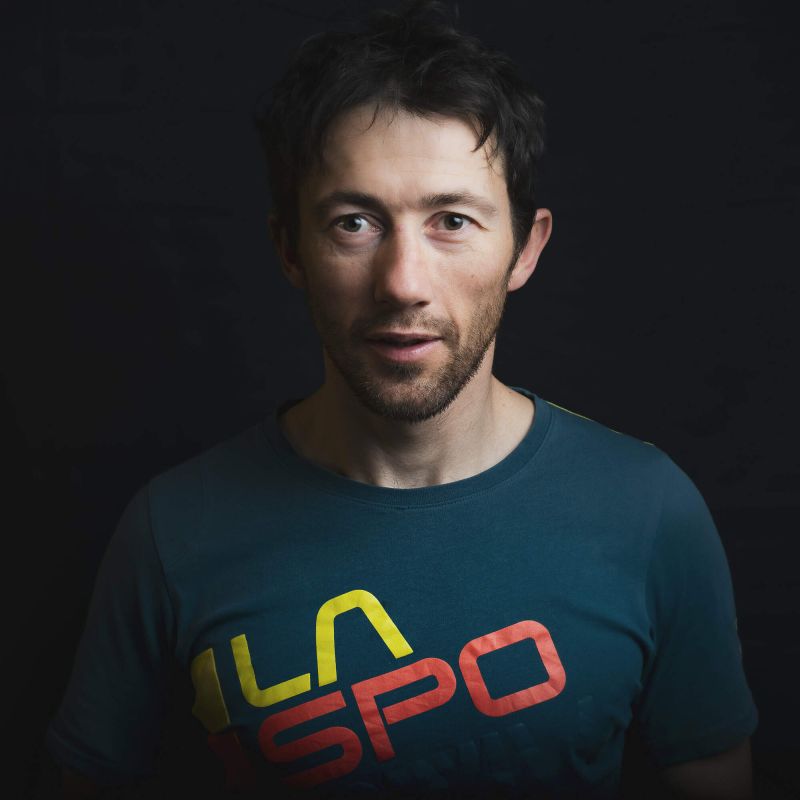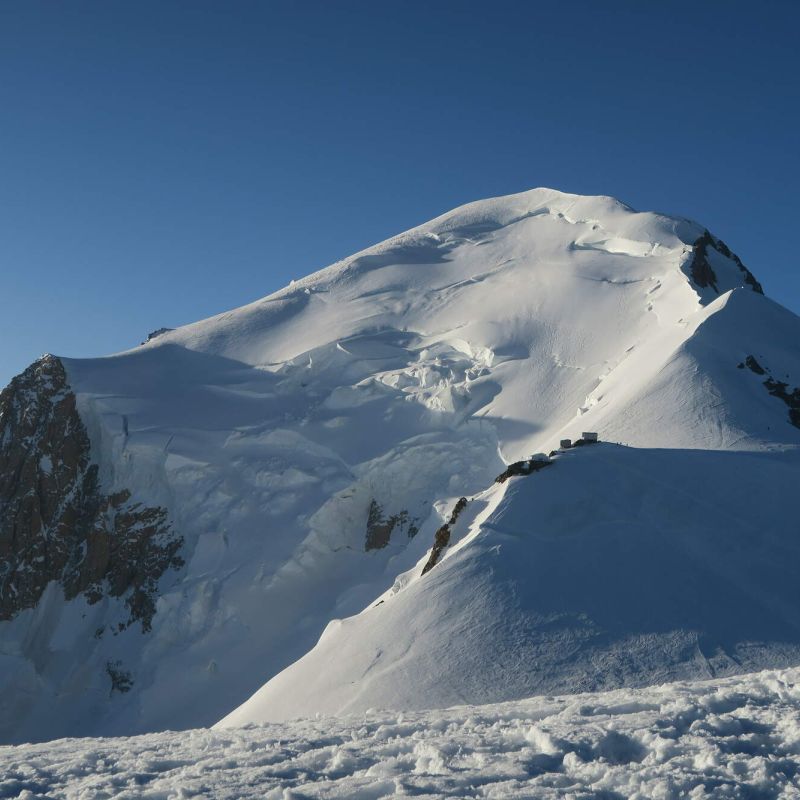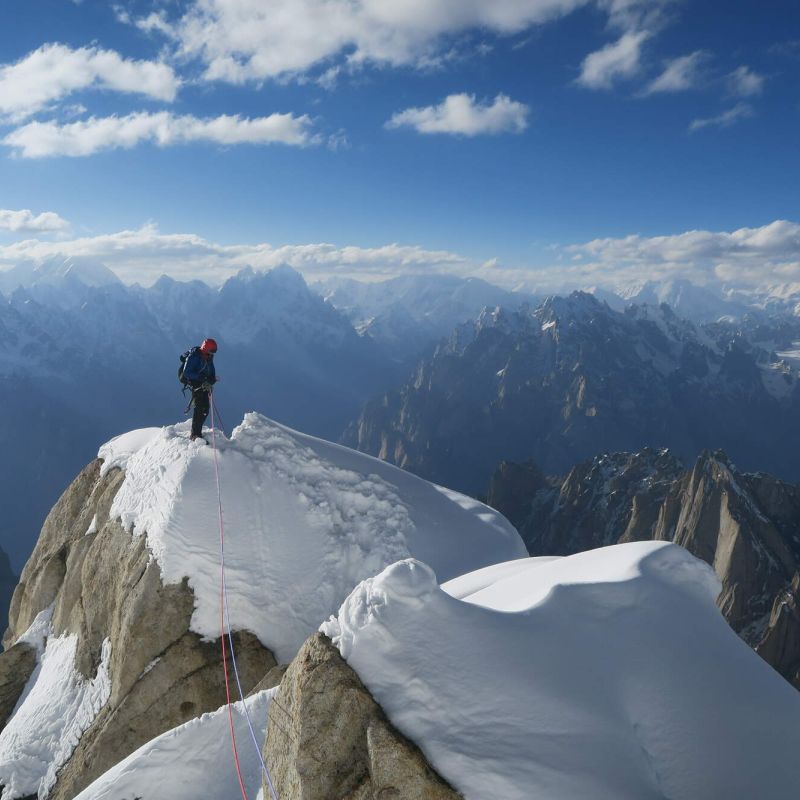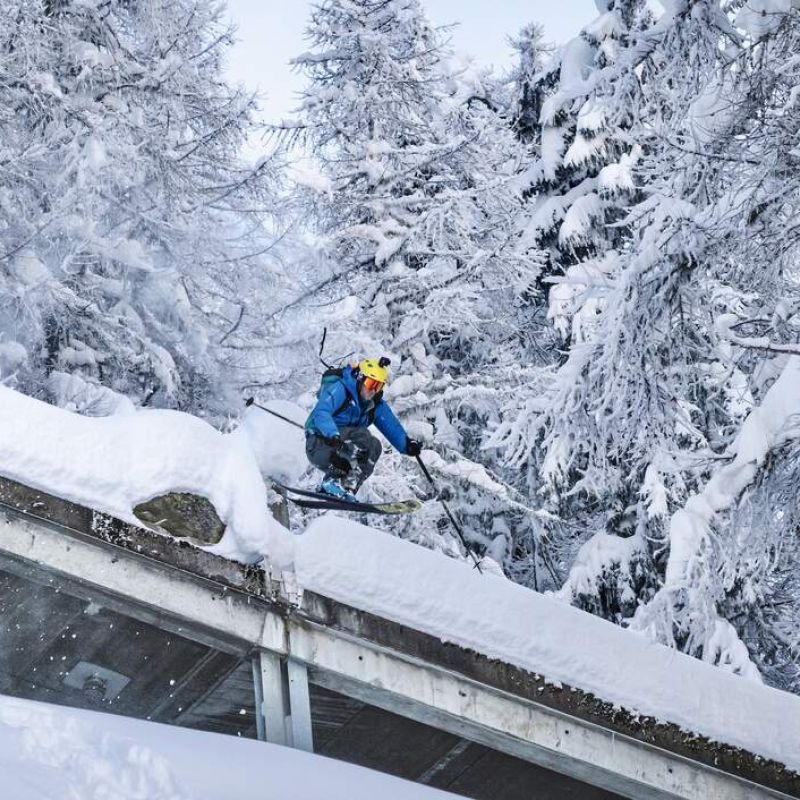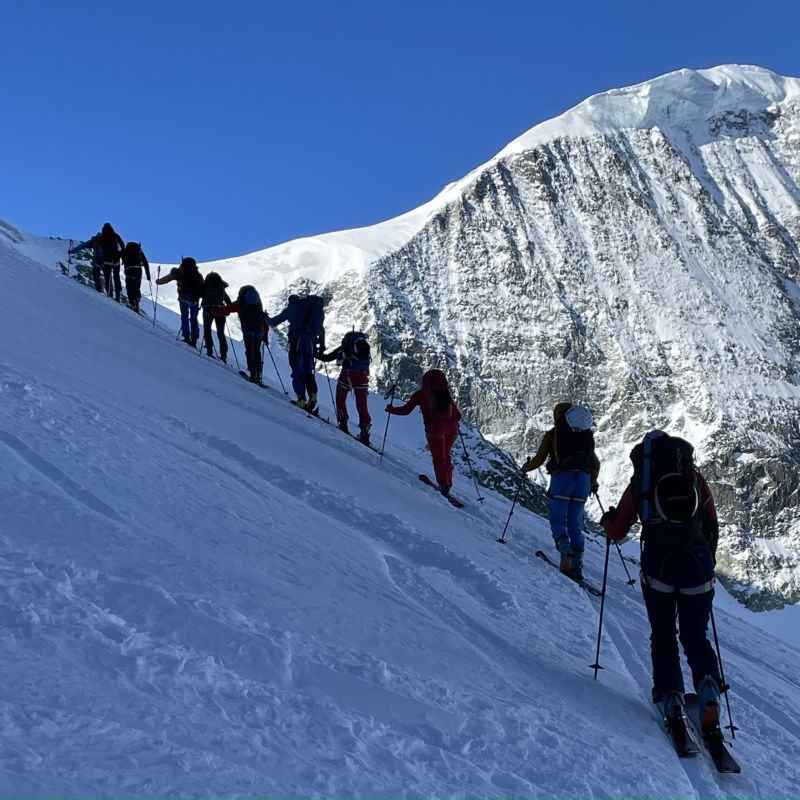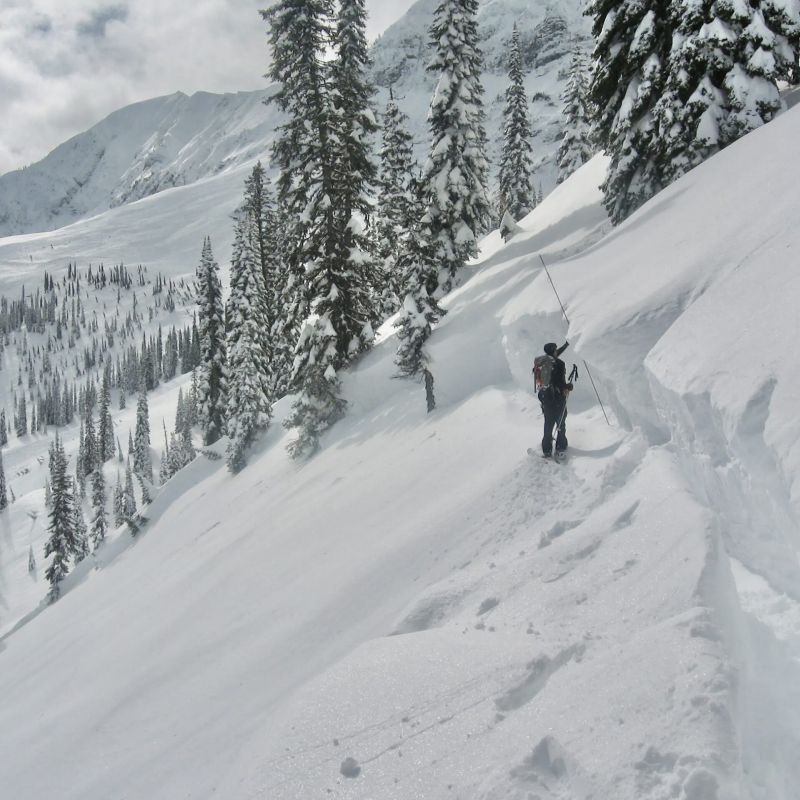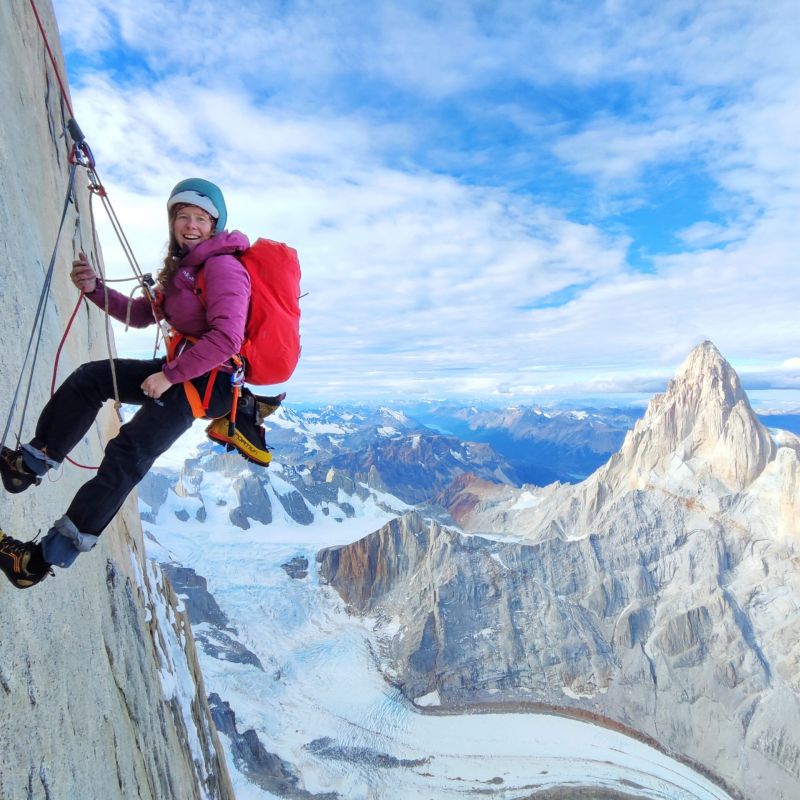The Grandes Jorasses North Face Story – Legendary Alpine Climb
The North Face of the Grandes Jorasses has captivated generations of alpinists. Its vast wall of rock and ice, sculpted by time and weather, is a monument to alpine history, marked by triumph and tragedy alike. Rising 1200 meters above the Leschaux Glacier, its massive granite spurs plunge from the four peaks of the watershed ridge, their prow-like pillars slicing into couloirs of black ice. Invisible from the Chamonix valley floor, the wall stands aloof and alone — cold and hostile in winter, dry and treacherous in summer. It can be climbed year-round, but its ascent is never to be taken lightly.
A Century of Triumph, Tragedy, and Personal Odyssey on One of the Alps’ Greatest Walls
The North face of the Grandes Jorasses is considered, along with the North faces of the Eiger and Matterhorn, to be one of the three great problems of the Alps, attracting mountaineers from all over the world. The first attempts date back to the 1920s, when ropes were made of hemp and pitons rarely used. There was something poetic about these attempts. Unfortunately, some of them ended in tragedy. The race to be the first to climb the North face was won by the Germans Peters and Meier in 1935, climbing along the Croz spur. The legendary Italian climber Riccardo Cassin along with Tizzoni and Esposito succeeded on the Walker Spur in ’38. At the time, this was the most coveted climb in the Alps and certainly one of the most striking ascents to date.
The post-war period saw the emergence of a whole new generation of fierce mountaineers, but once the virgin walls were finished, the attention of the strongest moved on to the « firsts winter ascents”. Walter Bonatti’s winter ascent of the Walker Spur in 1963, repeated days later by René Desmaison in stormy weather represents a milestone in mountaineering. Bonatti succeeded on the Jorasses with feats that lived up to his reputation, such as the first ascent of the dangerous line leading to Whymper Peak roping up with Michel Vaucher in 1964. Desmaison was responsible for three new major climbs. In 1957, with Couzy, he climbed the obvious pillar of the Punta Margherita. In 1967 he opened the “Linceul”(the Shroud) perhaps the last great ice climb ascended by cutting steps with a single straight axe.
Finally, in the winter of 1971, with Gousseault, he set out to open a direct route to Walker Peak, but after several days of fighting against the cold and difficulties they were stuck a mere 80 meters below the summit due to Gousseault’s exhaustion. René Desmaison stayed on the ledge, stuck alongside his companion even after his death, and miraculously survived several more days until help finally arrived. He returned in 1973, with Bertone and Claret, to finish off the climb. Those years also saw the advent of Himalayan-type sieges. The gully to the right of the Walker spur was attempted by Bonington and Haston. In the winter of 1972, during 17 days, the team that had known almost no failures tried to reach the summit in vain. In the meantime, it took a Japanese team 35 days to conquer the Central Couloir.
The winter of 1974 was a season of success on the Direttissima on the Whymper Peak, the most coveted and hardest line yet, for Yannick Seigneur and his companions. It took them 19 days on the wall, divided into two attempts, fixing ropes and even airlifting food and gear, to solve the “Directe de l’Amitié”. Colton and McIntyre dusted off the line already attempted by Bonington and Haston in a lighter style and during two days of July 1976, completing the line that would become one of the most classic mixed climbs in the Alps.
At the end of the 70s, several routes were climbed on Croz Peak, one by the Poles Kurtyka and Kukuczka, who later became legends of Himalayan mountaineering, and one by the Slovenians, whose climbers included Francek Knez, known for his routes in the Dolomites and on extreme walls all over the world. The Czechs were responsible for the success of the “Rolling Stones” route on the Walker Spur, which would later become one of the most sought-after routes in the massif.
The first winter solos by Hasegawa on the Cassin and Ghirardini on the Croz spur also date from that period. In the 80’s the Jorasses became the scene of fast solo ascents and linkups often with external help and a helicopter never far away. In 1985 Eric Escoffier linked the Croz and Walker spurs on the same day. Two years later in 1987 Christophe Profit linked the three great north faces, Eiger, Matterhorn and Jorasses, first in summer, then in winter in 45 hours non-stop. The last new routes such as No Siesta and the Gabarrou-Long went almost unnoticed because so much attention was focused on these races against the clock.
In 1991 Slavko Sveticic achieved a great feat by soloing the Manitua route on the overhanging face of Croz Peak. This marked the beginning of a decade of solo climbing, with long periods on the wall, such as Lafaille’s route on the Croz spur with once again helicopters and cameras following the climbers closely.
In July 1998 the Russian Babanov opened Eldorado, a very hard route on Whymper wall, which would be repeated by another solo specialist, Lionel Daudet, in winter with very difficult conditions.In the last two decades the possibility for new lines, such as those climbed by of Gabarrou and his partners, have stretched thin and the least that can be said is that today there is no corner of the wall that has not be climbed.


My Personal Journey with the North Face
My story with this wall begins early by reading the stories of Bonatti, Cassin and Rebuffat. At the time I was twenty-years old and thirsty for adventure so I moved to Chamonix and voraciously started to climb any route that seemed within my reach. A few days after a solitary adventure on the North face of the “Piller d’Angle”, I told myself that the time had come to attempt the Walker Spur. Common sense suggested that I find a partner and so it was that my friend Peter Mason and I set off from the Montenvers train station, feeling slightly incredulous at the idea of finally going to try this legendary climb.
Retracing passages that I had already climbed dozens of times in my dreams left me with a feeling of déjà vu as we ascended the steep spur. Finally crossing the summit corniche was an unforgettable moment, i remember feeling that i had become a real mountaineer.
In the following years I found myself below the wall several times, repeating great classics like the Linceul, the Croz Spur or the Colton-McIntyre, accumulating vertical kilometers and experience and waiting for the right moment to try the more difficult routes at which I looked at in awe. There was no shortage of unsuccessful attempts as this was time when, social media being at it’s early stages, you still had to go and see up close to know the conditions.
In the autumn of 2011 the long-awaited moment finally arrived, the anticyclone seemed well established in the Alps, and with a friend we repeated Monomania, a route recently opened on the right of the Shroud. I could see that the upper part of the wall was in excellent condition, so I convinced my friend Jeff Mercier to attempt the famous No Siesta. This route was on everyone’s lips and we were eager to try it. We hiked up the glacier to the bottom of the face and, without delay, we started climbing in the afternoon.
As expected, the first section was steep and dry, making progress slow and difficult but we persevered and overcame the steep slabs. We managed to gain the foot the steeper part of the wall, hoping to find a place to bivy. Jeff managed to find a providential niche. Shivering through the night, I regretted not having taken a sleeping bag.
The following day, we were able to ascend fairly quickly to the summit. We linked the runnels of delicate ice by etching the front points of our crampons and axe blades over the corse granite, marveling at the beauty of this difficult line. The itinerary seemed obvious and we were surprised to discover we had gone off route by following a steep grey corner. Jeff built an anchor with the little material he had left. I caught up with him and took the lead, climbing up a stretch of loose rock to reach a small hanging snowfield.
Above, the steep wall loomed into the darkness. It was time to chop up a suitable place for a bivy. It was obvious that the night would be uncomfortable so we ate something before trying to carve a couple of seats out of the rocks and ice. Jeff dug as deep as he could into the hard black ice until he had enough room for a single buttock and, satisfied with his work, quickly drifted into sleep. In the meantime, finding no other possibility, I had to move a few meters to the right to place another belay.
A protuberant rock would finally be my perch for the night as i patiently waited for the first lights of dawn. After this cold and short night we joyfully set off again. Jeff lowered me fifteen meters to the right and I ended up finding a piton. I was happy to point out that the route could be reached with a short rappel but Jeff, not very enthusiastic at the idea of making a complex maneuver, laconically told me to find a passage straight ahead. I climbed back up to the belay and started diagonally up the wall above us.
Thanks to a few providential holds and some technical moves, I quickly found myself on easier terrain at the foot of the final gully, quickly ascending on the steep ice and by early afternoon we had reached the summit. We were happy to have succeeded in the free ascent of this route, not that it is important on a big alpine wall, but it felt good for the ego.
During the long descent I promised myself that in the near future I would only go cragging. This decision did not last long. The call of the Desmaison-Gousseault, a route that I had dreamed of for years, gave me the necessary strength to forget the fatigue and body aches and to go for another round.
The Desmaison-Gousseault has a legendary status linked to the drama surrounding the first attempt in 1971. The two Frenchmen were stranded only 80 mt below the summit, after climbing in winter on t 70 degree mixed ground for 6 days. Goussault died and Desmaison miraculously survived. This time again, I easily convinced my friend Pete Mason to come and we headed for the wall whose ghostly shadow enveloped us as we finished the long walk in.
That evening, at the bivouac, we tried to play down the inevitable nervousness caused by the knowledge of the drama experienced by the first ascentionists. We chose to sleep on the glacier below the wall, a cold place but comfortable, our sleep disturbed only by the whistle of a solitary stone crashing close by. A few hours before dawn, we awoke to melt some snow and started talking about the whistle and the thud at night: ”Maybe bivouacking below a route called Rolling Stones wasn’t such a good idea,” said Pete, lighting the stove. ”Well, fortunately we’re sheltered under this overhanging wall of ice,” I replied. Looking off 20m to the right, the said wall that had collapsed in the night creating a pile of blocks.
That day we rapidly made our way up the gullies, icy ramps and steep walls of reddish rock, chossy as always in the Grandes Jorasses. As we moved up the conditions improved considerably. Again, I found myself on sections of the climb that I felt I had already climbed in my mind several times. At the end of the day we reached a snowfield which formed a characteristic fin in which we managed to chop two comfortable ledges for the bivouac.
The following morning, Pete was feeling a little ill and left me with the task of getting us out of the wall. Taking the sharp end of the rope always keeps my concentration high and that little bit of adrenalin prevents me from feeling hungry or thirsty and dulls all the little aches. Once again, with a little dry tooling and boldness, the climb came out clean and not too difficult. Perfect mixed climbing.
At each belay, I scanned the wall, thinking of Desmaison with only one ice axe and a handful of pitons, of his devastated hands after six days of climbing on a mixed route without gloves. For us, although everything was much simpler, it was still serious and committed so we maintained a high level of concentration. Finally, we passed a vague ledge on which we could see an old tattered rope and a cooker that made us think with a shudder of the drama of 71. We climbed the fateful 80m and were relieved to reach the summit. Phew.
Summer 2014, the bad weather rages over the massif. I had never seen the mountains so white! Busy with the ENSA guiding courses we had decided to climb the Tronchey Arête, a beautiful climb in a wild environment on the south side of the Jorasses. As we ascended I realized just how much ice there was on the walls. Since I had brought only one ice axe, I found myself balanced on thin ice while the grade 4 rock pitches had transformed into steep snow and ice.
On the way down we passed several roped parties that had come off of the north face. They reported incredible conditions so obviously I began getting a bit excited and at the end of the final exams I set off towards the wall, alone, intending to solo the Polish route. This beautiful and ephemeral flow of ice, to the right of the Croz Spur, is rarely climbed.
During the night I found it difficult to sleep. In my mind there were so many question marks. The rare repeaters had spoken a couple of very delicate pitches. I wondered if I should not have gone to the Colton McIntyre instead, which had been climbed several times recently. Once on the path, alone under the stars, the doubts dissipated. I knew why I was there, and it was certainly not to be with all the other parties and to climb a route which I had already done with a companion.
I started to climb without stopping at the bergshrund. The wall steepened out but the hard snow allowed me to climb swiftly. I arrived at the key part and very sure of myself I climbed upwards, jamming my picks into the cracks and choosing my footholds carefully. I have always found that climbing unroped on steep mixed terrain is even more delicate than on rock or ice.
You have to be able to trust what little contact there is between the climber and the mountain, sometimes it’s just the tip of the ice axe hooked into a notch of fragile rock. I set foot on an almost vertical slab of ice, it made a dull noise but seemed solid and gradually the ice became thicker again and turned into a beautiful gully. Only two hours and ten minutes after the start I reached the summit. With pleasure I managed to descend before the conditions of the glacier became dangerous and by midday I was in the valley.
A completely different adventure followed, with Martin Elias on the “Directe de l’Amitié” possibly the steepest and most complex route on the wall. We decided to make the ascent as quickly as possible with only two light rucksacks. Once at the hut we observed the wall for a long time trying to read the line.
We also found, among the hut’s topos, a detailed article on the ascent of Seigneur and his companions in 1974 and a recent attempt by a German team which had ended up in a rescue. We were the last to leave the hut, so as to be alone, and we quickly walked to the foot of the face. After simul-climbing hundreds of meters of steepening snow runnels we reached the foot of the vertical wall.
The hard snow disappeared and we found ourselves dry tooling at our limit. I climbed three hard pitches and, content with the efficiency of our progression, I stopped below a 30 meter overhang of brown rock.
Martin took the lead, taking the the few pitons we had brought along. He struggled a bit due to the bad rock but managed to make progress. As is often the case with aid climbing without the right equipment, a single pitch can take several hours and this pitch was no exception.
As the sun went down on the horizon I began to think about where we could “sleep” on this vertical wall. The belay from which I was hanging was very uncomfortable and my body felt shattered. For hours I imagined myself digging in the snow on the slab just above the belay and making a place to sit. Martin finished the pitch and after fixing the rope, came back down. While he was recovering from the effort I climbed a few meters and started to dig into the shallow snow patch but too soon the ice axe hit the rocks and, as a string of curses echoed through the cold night, the small hope of spending a decent night faded.
Martin laughed and started dinner which consisted of a packet of biscuits and a cigarette. I did what I could using long loops of rope as a hammock and we settled down. We wrapped our chests in webbing to avoid falling forward and, as we could not remove our crampons, we rolled the sleeping bag around our legs and prepared to spend an awful night.
Morning finally arrived and we climbed up the fixed rope with the firm intention of not having to bivouac again. The upper part of the route revealed some of the most beautiful mixed pitches I have ever climbed, beyond all my dreams. After a final obstacle, a roof that ends in an ice stalactite, we reached the summit ridge. A deep feeling of happiness flowed through us as the sun warmed our cold and tiered bodies. We were incredulous and very satisfied with this fast ascent.
That winter, I had already climbed 5 routes on the Grandes Jorasses in a month and a half: Tronchey ridge, Polish route, Margharita spur, Directe de l’amitié and Japanese route. Needless to say, I thought i was done with it for a while, but at the end of winter 2015, some good weather invited us to return to the mountains. With the trusty Martin we chose Rolling Stones, perhaps the longest route on the North face. Little repeated, the route is imposing. The aim was not only to climb it but also to climb it free and possibly quite fast.
After an approach on skis in the early afternoon we overcame the Bergshrund and climbed up a beautiful gully. Shortly after Martin broke one of his picks. Unfaded we kept climbing the beautiful pitches that followed, and happy with our quick progression we settled down to bivouac on an uncomfortable ledge exposed to the wind and powder snow drifts. The next morning was very cold so we delayed our departure. I felt pain in my lungs but we decided to continue although retreat at this point of the climb did not seem too difficult. Pitch after pitch we made steady progress and despite the intense cold, and we reached a little balcony under the key section.
Despite the fact that there were still a couple of hours of daylight left, we stopped to bivy and decided wait to see how I would feel the next morning. In the morning we delayed the start again, I was freezing cold and my lungs were burning but when the sun warmed us a little I felt like i could keep going. Still climbing free I ascended the two key pitches and we quickly found ourselves on the edge of the spur where it merges with the Cassin route. Now on familiar ground we increased our pace and in the early afternoon we embraced on the summit, for the sixth time that winter!
The following summer I completed the most recent route of the collection of lines that I had always wanted to climb. Together with Tomas Muller we followed the excellent Manitua, climbed solo by Slavko Sveticic . The climb ascends the vertical monolithic wall left of the crest of the Croz spur and is an astonishing route. Ideal for dry summer conditions. We made very fast progress thanks to good conditions and strategy, it took us 12 hours from the bottom to the summit.
Today I prefer to focus on other walls, but it is always with great pleasure that I sometimes pause in front of this great wall on which I have experienced many wonderful days of mountaineering.






